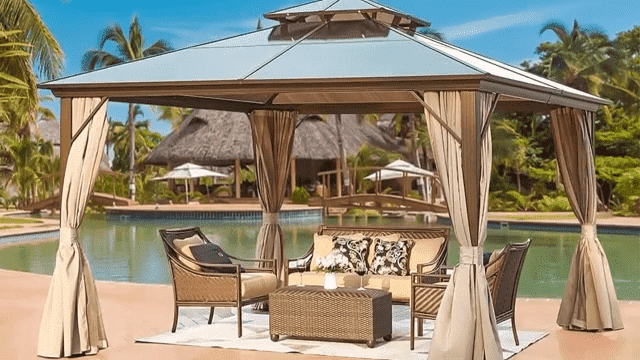How to Waterproof A Gazebo Canopy. Using canopies is an excellent way to stay cool and protected from the sun, but they can be a hassle to make waterproof. If you see that your gazebo or canopy is leaking water or not keeping the rain away, you might need to do something about it.
Fixing it is not that hard, but you need to know that it depends on what material you’re working with. It’s important to learn how to waterproof your canopy to fix any problems.
However, there’s a solution to this problem, which will allow you to enjoy all the benefits of a canopy without worrying about water damage.
How to Waterproof a Gazebo Canopy: To keep your gazebo canopy in good condition, it’s important to waterproof it. If it gets wet, it can cause issues like mold, mildew, and rotting. This can be bad for the wood and metal parts. In this blog post, we’ll teach you how to waterproof your gazebo canopy with easy steps!
How to Keep Your Gazebo Dry During Rainy Weather
It’s important to protect your garden gazebo from rain to keep it in good condition and make the most of it. There are a few ways to do this, each with its own pros and cons.
There are several methods to protect your garden gazebo from rain. The first one is to use a tarpaulin sheet to cover the top of the gazebo, but it can be challenging to attach without hooks.
The second method is to use waterproof covers for each side of the gazebo, which is easier to attach and remove but can be more expensive.
The third method is to buy an umbrella that covers the entire gazebo, but it may blow away in high winds.
The fourth method is to buy an all-in-one waterproof cover that covers the entire gazebo frame and canopy, but it is the most expensive option.
The fifth method is to buy an all-inclusive package that includes everything from the groundsheet up, but it can be costly.
How to Make Your Gazebo Canopy or Canvas Waterproof
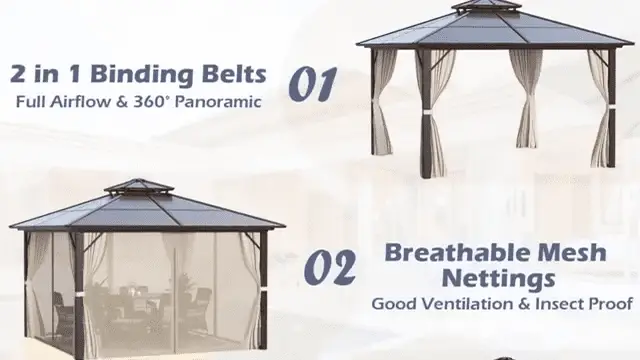
You can waterproof a gazebo canopy or canvas in different ways. But not all methods work for all materials. So, you need to choose the right method based on what you want and the material of your canopy or canvas. Here’s how you can do it:
Using a Liquid Sealant:
If you want to permanently waterproof your gazebo canopy, you can try using a liquid sealant instead of a spray. This method is easy and less messy. To do this, you will need a paintbrush or roller brush and a silicone-based liquid sealant.
Start by cleaning the canopy cover in the washing machine and letting it dry. Then, use the brush to apply the sealant evenly on all sides, including the top and bottom, and tape any seams to prevent leaks.
If you want a stronger waterproof barrier, consider using an epoxy-based sealant that can be applied directly with a brush.
Using Vinyl Coatings: A Beginner’s Guide
Another way to make your gazebo canopy waterproof is by using vinyl coatings. These coatings can be found at most hardware stores and can be used to seal the canopy. They work by preventing water from seeping through the material.
You can apply the vinyl coatings by painting or spraying them onto the surface of your fabric. You can also purchase a pre-made coating spray that is easy to use, or make your own by mixing equal parts water and vinyl paint in a container.
Make sure to apply the coating evenly on all sides of the fabric and let it dry completely before using your gazebo again.
Using a Spray: A Comprehensive Guide
The easiest way to waterproof a gazebo canopy is by using a spray. You can buy a waterproof spray or make your own. If you choose to buy one, make sure it’s made of fabric, and read the instructions carefully. Before spraying the whole canopy, try it on a small area to make sure it works well.
Using Waterproof Paint: A How-To Guide
Another option to waterproof a gazebo canopy is by using waterproof fabric paint. This can be found at most hardware stores and is easy to apply.
Although it may not be as durable as a waterproof sealant, it is a good choice if you want to protect your canopy from rain. To use this method, you need to apply two coats of paint, making sure to cover the entire surface of the canopy.
Each coat must dry completely before applying the next one. It’s important to note that this method is not permanent and needs to be reapplied after each use.
If you’re not experienced in painting, it might take a lot of time and effort to get good results. You can try using a pre-made kit with instructions if you’re new to painting.
However, avoid using waterproof paints that contain petroleum distillates such as kerosene or xylene because they can cause health problems if inhaled over time.
What to Expect When Waterproofing Your Gazebo

It is important to know whether your canopy is designed to be waterproof, water-resistant, or only for dry use. Not all canopies are meant for use in wet weather, so it’s best to research which one is best for your needs before buying.
For instance, if you’re selling things at a farmers market every weekend, you’ll need a strong canopy that won’t drip water onto your products or decorations during rainy weather.
If you’ve already bought a canopy, check the information provided by the manufacturer to see what it’s designed for.
If you can’t find the information, the section below can help you understand some general material properties and give you an idea of how well your canopy can handle water.
Understanding Canopy Fabric and Its Waterproofing Properties
Polyester is a type of fabric that is commonly used in pop-up canopies, gazebos, and tents. While polyester itself is not waterproof, it can resist water if it is thick enough.
Some manufacturers apply a waterproof coating on top of the polyester, which can be made of polyurethane or silicone.
However, if your canopy is made of pure polyester with no waterproof coating, it won’t be completely waterproof. But there are things you can do to help make it more water-resistant, like using a water-repellent spray or seam sealant or fixing any obvious holes.
Some heavy-duty canopies are made of polyurethane, which is very waterproof but heavy. Canvas is another type of fabric used for canopies and is naturally water-resistant, but you need to be careful applying anything to it, as it may ruin its natural water-resistant properties.
Options for Waterproofing Your Gazebo or Canopy
It’s important to know what water problems you’re trying to prevent when using your canopy. If you get wet under your canopy when it rains, figure out where the leaks are coming from.
You can set up your canopy in your yard and have someone spray water on the roof to see where the water leaks through.
Here’s what you can do if you find:
- Holes or tears in the fabric: use a patch repair kit.
- Water is not running off the fabric: use a water repellent spray on the outside of the fabric.
- Water is soaking through a polyurethane fabric or coating: restore the coating with a sealant.
- Water is seeping through seams: patch the leak with sealant.
How to Fix a Tear or Small Hole in Your Canopy:
First, clean the torn area with rubbing alcohol and a cloth. Then, cut a piece of tent repair tape big enough to cover the tear and leave some extra space around it. Put the tape over the hole and press it down on a flat surface.
Wait for the time specified by the tape manufacturer for the patch to stick to the fabric. If the tear is in a high-stress area, you might need to patch both sides of the fabric. Finally, put the tent back in its bag.
How to Make Your Canopy Fabric Waterproof Using Water Repellent Spray or Treatment:
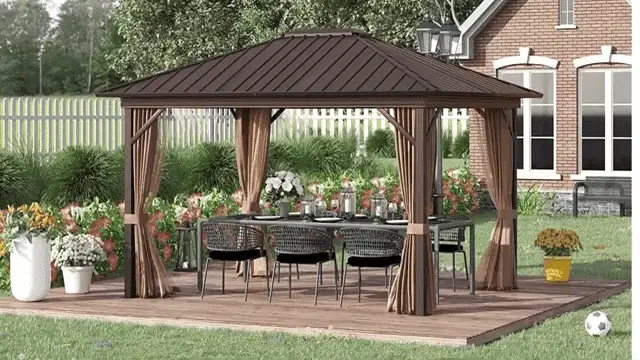
To waterproof your canopy, follow these general steps:
- Set up your canopy or gazebo at a low height that’s easy to reach.
- Shake the waterproofing spray well.
- Test a small area of the fabric to make sure the spray won’t damage it.
- Hold the can about 15-20 cm away from the fabric and spray evenly over the entire surface.
- Let the first coat dry completely, then apply a second coat.
- After the second coat dries, drip some water on the fabric to see if it beads off. If it doesn’t, apply a third coat.
How to Waterproof Your Canopy: A Step-by-Step Guide
Here are the steps to make your canopy waterproof:
- Clean your canopy.
- Apply seam sealer and wait for it to dry.
- Use a sponge to remove any old waterproof coating that is peeling or wearing off.
- Spray the whole canopy with waterproof spray.
- Allow it to dry completely.
Cleaning Your Canopy:
To clean your canvas canopy, first, lay it on a drop cloth to protect it from debris. Then, use a hose or power washer to spray it down and scrub away any stains. Flip the canopy and repeat the process on the other side. Allow both sides to dry completely in the sun.
Making Your Own Seam Sealer:
Let’s learn how to make our own waterproof canopy! Instead of buying a pre-made seam sealer, you can make one yourself using these items:
- Mixing container
- Paintbrush
- Canopy cleaner or gentle liquid soap
- Clear silicone caulk
- Mineral spirits
First, make sure you clean your tent using a canopy cleaner or soap and water. Then, mix equal parts of clear silicone caulk and mineral spirits in a mixing container using a paintbrush until it forms a paste. This paste can be used to protect your tent from water seeping through the cracks.
Applying Seam Sealer:
If you want to protect your pop-up canopy from water, you can either make a seam sealer yourself or buy a pre-made one. To start, you need to clean your canopy. Apply the seam sealer to the seams of your canopy and let it dry completely. This will help to make sure that water does not leak into your special event, making sure your canopy lasts longer.
Waiting for a Sunny Day:
Wait for a sunny and dry day to make your canopy waterproof. Don’t attempt this on a rainy day.
Applying Waterproof Spray to Your Canopy: A Step-by-Step Guide
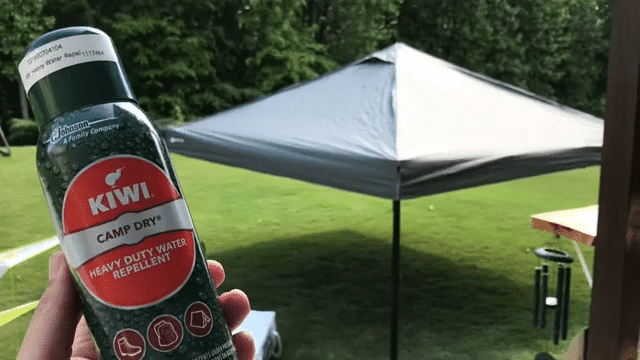
Waterproofing your canopy is an easy task with the help of waterproof spray. Here are the steps you should follow to make your canopy waterproof:
- Set up your tent or lay your tent top on a drop cloth on the ground.
- Use mild warm water to wash your tent top. This is an essential step for any method of waterproofing.
- Spray the entire canvas with the waterproofing spray.
- Let the tent top dry, and use a damp cloth or sponge to wipe away any excess spray.
- Apply a second layer of waterproof spray to ensure full coverage.
Different Types of Waterproof Tents:
Whether tents are waterproof depends on the type of tent you have. While most tents can resist water to some extent, tents from brands like American Tent offer more protection against water than others. These types are as follows:
Making Sure Your Tent is Waterproof:
A waterproof tent is the best option if you want maximum protection from water. These tents are made of stronger fabric with a solid waterproof layer and can handle more pressure than other types of tents.
However, no tent can be completely waterproof. It’s important to use the right materials and prepare properly for the best possible outcome.
Understanding Water-Resistant Fabrics:
This gives you a basic level of protection. When the fabric of the tent is tightly woven, it acts as a barrier to prevent water from getting inside.
Choosing a Water-Repellent Tent:
A water-repellent tent is the second level of protection. These tents have an extra coating that helps to resist rainwater. The coating causes the water to bead up and roll off the top of your canopy.
How to Test If Your Tent is Waterproof?
To know how waterproof your tent is, you should ask the seller. At American Tent, we guarantee that all of our tents are waterproof.
But, it’s important to know the waterproof rating of other tents before buying. If you have a tent that isn’t waterproof, you can use a seam sealer and waterproof spray to make it waterproof.
After using your tent in the rain, check the seams for any signs of water seeping through. If you notice any weak spots, just apply the extra spray to fix them.
The Best Way to Restore a Canopy’s Waterproof Coating
If parts of your canopy have degraded coating, you can refresh the coating in those areas with a suitable sealant. You should make sure you buy the right sealant for your canopy material.
To start, find the degraded patch of canopy material and lay it out flat. Then, use a slightly rough scrubbing sponge and rubbing alcohol (like methylated spirits) to gently remove the flaking parts of the coating. After that, apply the sealant evenly according to the manufacturer’s instructions.
Finally, let the sealant dry for the recommended time before using or storing the canopy.
Are you thinking about Buying a Water-Resistant Tent?
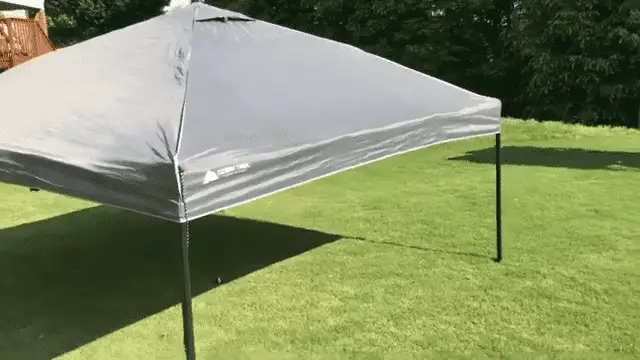
If your gazebo material is not waterproof or it’s starting to leak, you may want to consider buying a new heavy-duty waterproof tent top from American Tent. Even if you don’t have a tent yet, now is a good time to get one. We have some of the best pop-up canopies for rain, so we will make sure you get a tent that can withstand any weather.
Canopy Should be Reinstalled
To reinstall the canopy on your gazebo, follow the steps, that we discuss below!
- Make sure the frame is clean and free from any dirt or debris that may have accumulated during the removal process.
- Place the canopy over the frame, making sure it is centered and aligned properly.
- Attach the canopy to the frame using the fasteners or clips provided with the gazebo. Make sure each clip or fastener is securely attached to the frame.
- Pull the canopy taut and adjust it so that it is evenly stretched over the frame. This will help prevent any sagging or pooling of water.
- Check that the canopy is not twisted or wrinkled and adjust it as necessary.
Make sure the canopy is properly secured to the frame to ensure that it does not come loose or blow away in windy conditions.
Check the Waterproofing
After you have let the canopy dry and reinstalled it on the frame, the next step is to test the waterproofing. You can either wait for a rainy day or use a hose to simulate rain and test if the canopy is waterproof.
If you find that the canopy is leaking, then it’s important to repeat the waterproofing process. You can apply a seam sealer and waterproof spray as needed, following the manufacturer’s instructions.
Once you have reapplied the waterproofing products, wait for them to dry before testing the canopy again to ensure it is fully waterproof.
Factors to Consider in How to Waterproof Gazebo Canopy
There are several factors to consider when making a gazebo canopy waterproof:
Size and Shape of the Gazebo Canopy
When it comes to waterproofing a gazebo canopy, the size and shape of the canopy are important factors to consider. A larger canopy will require more waterproofing spray or sealant, and may also have more seams and joints that need to be treated.
The shape of the canopy can also impact how water flows off the surface, so it’s important to apply waterproofing products evenly and thoroughly to ensure full coverage.
Additionally, the shape and size of the canopy may impact how it is secured to the frame, so it’s important to follow the manufacturer’s instructions for installation and tightening the canopy to prevent water from pooling or seeping through gaps.
Budget for Waterproofing and Maintenance
When considering how to waterproof a gazebo canopy, budget is an important factor to keep in mind. Some waterproofing methods, such as purchasing a new waterproof canopy, may be more expensive than others, such as using a waterproof spray.
Additionally, ongoing maintenance costs should be considered, as some waterproofing products may need to be reapplied periodically to maintain their effectiveness.
It’s important to weigh the cost of different waterproofing options against their effectiveness and durability to ensure you’re making a worthwhile investment for your gazebo canopy.
Availability of Professional Services and Support
When considering how to make a gazebo canopy waterproof, it’s also important to think about the availability of professional services and support. In some cases, it may be necessary to seek assistance from a professional to ensure that the canopy is properly waterproofed and maintained.
Therefore, it’s a good idea to research and consider the availability of such services in your area before making a purchase or attempting to waterproof the canopy yourself. It’s also important to consider the cost of professional services and support, as this can vary depending on the provider and the extent of the work needed.
Additionally, it’s a good idea to look for a company that offers good customer service and support, as this can be helpful in case of any issues or questions that may arise during the waterproofing process or afterward.
FAQs:
Q:1 What is the Best Way to Waterproof a Gazebo?
If your gazebo is made of canvas, you can purchase a waterproofing spray that comes in two coats. The first coat covers the material, and the second one seals the finish after it dries. It is important to note that the spray needs to dry, so make sure to check the weather forecast before starting the job.
Q:2 How do I protect my Gazebo Canopy?
If you want to protect the metal frame from getting damaged by the weather, you can use a spray called Rust-Oleum Rust Inhibitor. This spray can prevent rust from forming and it’s really easy to use. When you apply it, it creates an invisible layer on the metal that stops rust from getting through.
Q:3 What is the best waterproof Spray for a gazebo?
In the past, we recommended a product called 303 Fabric Guard as the best spray to protect fabrics from water. It’s really good at keeping fabrics safe because it repels water and prevents stains from both water and oil. It’s a really high-quality product that works really well.
Q:4 How do I stop my Canopy from leaking?
Polyester is a material often used to make tents, pop-up canopies, and gazebos. But sometimes water can seep through the material and make everything inside wet. To prevent this, you can spray a special water repellent spray on the material.
You can also use a special glue called a seam sealant to make the parts where the material is sewn together stronger and more resistant to water. If you see a hole in the material, you can fix it so water won’t get in.
Q:5 Do Waterproofing Sprays Work?
Waterproof sprays are used to protect fabrics like leather, canvas, or suede from getting wet by filling the small holes in the fabric with a special material like silicone that pushes water away.
However, not all waterproof sprays are the same. Some sprays are made for certain types of fabrics, while others work better for activities that are not too intense or for activities that are more heavy-duty.
Conclusion:
In conclusion, waterproofing your gazebo canopy is an essential step in keeping it protected from water damage.
Applying a waterproof spray or using a seam sealant can help prevent water from seeping through the material and making everything inside wet.
It is important to choose the right product for your gazebo canopy material and to follow the instructions carefully to ensure maximum effectiveness.
By taking these steps, you can ensure that your gazebo canopy stays dry and protected, so you can enjoy spending time outside no matter the weather.
We hope you will be well aware of how to waterproof a gazebo canopy, after reading this comprehensive guide. If you have any questions, feel free to comment below!

